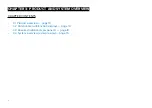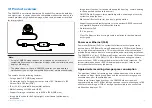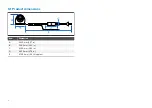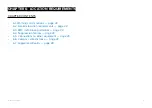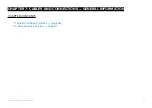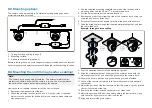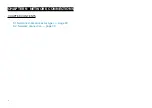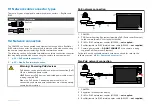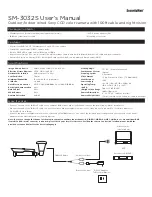
7.1 General cabling guidance
Cable types and length
It is important to use cables of the appropriate type and length.
• Unless otherwise stated only use cables supplied by Raymarine.
• Where it is necessary to use non-Raymarine cables, ensure that they are of
correct quality and gauge for their intended purpose. (e.g.: longer power
cable runs may require larger wire gauges to minimize voltage drop along
the run).
Routing cables
Cables must be routed correctly, to maximize performance and prolong
cable life.
• Do NOT bend cables excessively. Wherever possible, ensure a minimum
bend diameter of 200 mm (8 in) / minimum bend radius of 100 mm (4 in).
• Protect all cables from physical damage and exposure to heat. Use
trunking or conduit where possible. Do NOT run cables through bilges or
doorways, or close to moving or hot objects.
• Secure cables in place using tie-wraps or lacing twine. Coil any extra cable
and tie it out of the way.
• Where a cable passes through an exposed bulkhead or deckhead, use
a suitable watertight feed-through.
• Do NOT run cables near to engines or fluorescent lights.
Always route data cables as far away as possible from:
• other equipment and cables,
• high current carrying ac and dc power lines,
• antennae.
Strain relief
Use adequate strain relief for cabling to ensure that connectors are protected
from strain and will not pull out under extreme sea conditions.
Circuit isolation
Appropriate circuit isolation is required for installations using both AC and
DC current:
• Always use isolating transformers or a separate power-inverter to run PC’s,
processors, displays and other sensitive electronic instruments or devices.
• Always use an isolating transformer with Weather FAX audio cables.
• Always use an isolated power supply when using a 3rd party audio
amplifier.
• Always use an RS232/NMEA converter with optical isolation on the signal
lines.
• Always make sure that PC’s or other sensitive electronic devices have
a dedicated power circuit.
Cable shielding
Ensure that cable shielding is not damaged during installation and that all
cables are properly shielded.
Warning: Positive ground systems
Do not connect this unit to a system which has positive
grounding.
Connecting cables
Follow the steps below to connect the cable(s) to your product.
1. Ensure that the vessel's power supply is switched off.
2. Ensure that the device being connected has been installed in accordance
with the installation instructions supplied with that device.
3. Ensuring correct orientation, push cable connectors fully onto the
corresponding connectors.
4. Engage any locking mechanism to ensure a secure connection (e.g.: turn
locking collars clockwise until tight, or in the locked position).
26
Содержание CAM300
Страница 2: ......
Страница 4: ......
Страница 19: ...CHAPTER 5 PRODUCT DIMENSIONS CHAPTER CONTENTS 5 1 Product dimensions page 20 Product dimensions 19...
Страница 83: ...19 3 RayNet to RJ45 and RJ45 SeaTalkhs adapter cables Spares and accessories 83...
Страница 88: ......
Страница 92: ......
Страница 93: ......

